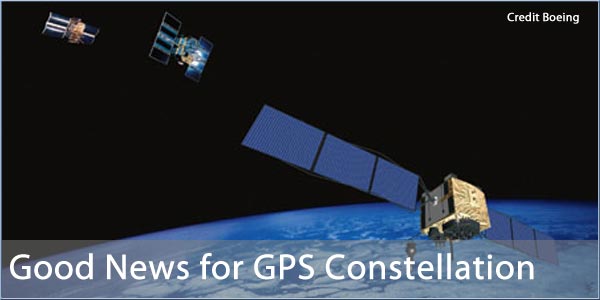|
|
 |
 |
 |
 |
Good news for the GPS Constellation this week
Article by: mike Barrett
Date: 24 Aug 2011

The last couple of weeks have seen some good news for the GPS Constellation. After the scare stories last year of the GPS Satellites failing and the USAF not being able to launch replacements quickly enough to prevent the GPS system stopping, a new GPS Satellite enters service and an old decommissioned Satellite was brought back online.
According to SpaceFlightNow.com GPS 2A-22 which was launched in August 1993 and decommissioned 2 years ago has been brought back to life to replace GPS 2A-27. Originally designed with a 7 year service lifetime the GPS Satellite has far outlasted its design life. GPS 2A-27 had been suffering from a faulty clock. The timing accuracy is the most critical component of the GPS as it is precise timing that enables the location to be calculated accurately.
Coming back to current time from 18 year old satellites. The latest GPS 2F-2 bird that was launched on July 16th has now completed its testing and has been inserted into the operational GPS Constellation. “The Air Force and allied military forces around the world use GPS devices in virtually every system to improve their capabilities and effectiveness while reducing risk to the warfighter,” said Air Force Col. Bernard Gruber, director of the GPS Directorate. “This next-generation GPS IIF satellite has been set healthy and is ready to begin providing a strong, clear and secure signal.”
The following is the official press release from Boeing:
2nd Boeing-built GPSIIF Satellite Enters Service with US Air Force
Navigation satellite healthy, ready for operation
EL SEGUNDO, Calif., Aug. 22, 2011 -- Boeing [NYSE: BA] today announced that the second of 12 GPS IIF satellites the company is building for the U.S. Air Force has achieved operational acceptance and entered service. With testing complete, GPS IIF-2, now called SVN-63, is the newest satellite to join the active 31-satellite GPS constellation operated by the Air Force 50th Space Wing and the 2nd Space Operations Squadron at Schriever Air Force Base, Colo.
“The Air Force and allied military forces around the world use GPS devices in virtually every system to improve their capabilities and effectiveness while reducing risk to the warfighter,” said Air Force Col. Bernard Gruber, director of the GPS Directorate. “This next-generation GPS IIF satellite has been set healthy and is ready to begin providing a strong, clear and secure signal.”
Boeing is responsible for the GPS ground and space segments, providing an integrated system solution for GPS IIF and for the operation of the entire constellation. As a prime contractor for GPS satellites for more than three decades, Boeing has delivered 40 spacecraft that are successfully populating and sustaining the GPS system. Boeing GPS satellites have demonstrated reliable performance and exceeded their operational design life. GPS IIF will form the core of the GPS constellation for the next decade or longer.
“GPS is deeply woven into everyday life and is the foundation of global, civil, commercial and defense applications for more than 1 billion users worldwide,” said Craig Cooning, vice president and general manager of Boeing Space & Intelligence Systems. “Boeing has a long legacy of support on the GPS program to the U.S. Air Force, and the delivery of this new IIF satellite augments the constellation’s ability to provide highly accurate, three-dimensional position, velocity and timing information 24 hours a day in all weather conditions.”
Launched on July 16, SVN-63 immediately entered verification testing using the Boeing-developed Operational Control Segment (OCS) system and government GPS ground assets and receivers. The OCS, which gained full operational status with the Air Force in April, enables an expanding set of services and capabilities, including improved anti-jam capabilities for warfighters and improved security for all users.
The flexible design of the OCS system enables new generations of GPS satellites, including GPS IIF, to be efficiently added to the constellation. On-orbit testing for the SVN-63 spacecraft took less time than for the first IIF satellite (SVN-62) because the testing on SVN-62 included a set of one-time, system-level design validation tests that involved the space vehicle, the OCS, and user equipment.
Boeing is building 10 additional GPS IIF satellites with the pulse line at its Satellite Development Center in El Segundo. The IIF pulse line efficiently moves a satellite from one work area to the next in a steady rhythm. Adapted from Boeing commercial airplane manufacturing operations, the pulse line will enable Boeing to deliver the spacecraft faster, more efficiently and with higher quality. Launch of the third GPS IIF satellite will be determined by the Air Force in the coming months.
| Comments
|
 Posted by navtrav on Fri Aug 26, 2011 8:10 am Posted by navtrav on Fri Aug 26, 2011 8:10 am |
 |
My VW is a useless warfighter - it's never left the ground.
What does this mean for mere mortals on wheels?
Tim
Tim
------------
Samsung Galaxy S4, Galaxy Tablet S, TomTom. Osmand+ and Sygic. Ex-TomTom Go 1000 Live, ex-TomTom Go 700, ex-TomTom truck, ex Navman/Ipaq |
|
|
|
 |
|
|
 |
 |
 |
 |
|
|